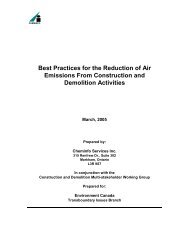Burrard Inlet Environmental Indicators Report - the BIEAP and ...
Burrard Inlet Environmental Indicators Report - the BIEAP and ...
Burrard Inlet Environmental Indicators Report - the BIEAP and ...
You also want an ePaper? Increase the reach of your titles
YUMPU automatically turns print PDFs into web optimized ePapers that Google loves.
<strong>Burrard</strong> <strong>Inlet</strong> <strong>Environmental</strong> <strong>Indicators</strong> <strong>Report</strong> February 2008<br />
are changes in <strong>the</strong> abundance of <strong>the</strong>se species over time, researchers can use a science-based<br />
approach to determine <strong>the</strong> underlying cause. By comparing trends here to o<strong>the</strong>r areas in <strong>the</strong><br />
Georgia Basin or to global trends, researchers can determine if local, regional or global factors are<br />
affecting <strong>the</strong> populations. Levels of organic contaminants such as dioxins, furans, polychlorinated<br />
biphenyls <strong>and</strong> polybrominated diphenyl e<strong>the</strong>rs have been studied in eggs of several species of<br />
birds in British Columbia (herons, osprey, pelagic <strong>and</strong> double crested cormorants, bald eagles <strong>and</strong><br />
petrels). Some of <strong>the</strong>se studies, discussed in Part 2, show linkages between contaminant levels in<br />
sediment, fish tissue (prey items) <strong>and</strong> bird eggs, <strong>and</strong> with improved environmental management<br />
practices, although effects at <strong>the</strong> population level are not always evident.<br />
Results <strong>and</strong> Trends<br />
Chart 3-1 shows <strong>the</strong> considerable variation in bird abundance from year to year <strong>and</strong> <strong>the</strong><br />
importance of looking for longer term trends <strong>and</strong> links to contaminants <strong>and</strong> habitat availability.<br />
Chart 3-1: Waterbird Abundance in <strong>Burrard</strong> <strong>Inlet</strong> Since 1975<br />
Bird abundance per observer effort<br />
45<br />
40<br />
35<br />
30<br />
25<br />
20<br />
15<br />
10<br />
5<br />
1.6<br />
1.4<br />
1.2<br />
1.0<br />
0.8<br />
0.6<br />
0.4<br />
0.2<br />
Christmas Bird Counts<br />
0.0<br />
1975 1980 1985 1990 1995 2000 2005<br />
Black Oystercatcher<br />
Double-crested Cormorant<br />
Glaucous-winged Gull<br />
Great Blue Heron<br />
Pelagic Cormorant<br />
Year<br />
SOURCE: Bird Studies Canada; Audubon Christmas Bird Count Data<br />
Glaucous-winged Gull populations in <strong>Burrard</strong> <strong>Inlet</strong> have decreased<br />
significantly since 1975. Abundance elsewhere in <strong>the</strong> Georgia Basin<br />
remains stable (Badzinski et al. 2005). Gulls are very sensitive to<br />
predation by <strong>the</strong> Bald Eagle, <strong>and</strong> <strong>the</strong>ir decreased abundance may reflect<br />
movement of gulls out of <strong>the</strong> <strong>Inlet</strong> as <strong>the</strong>y adapt to <strong>the</strong> increasing danger<br />
posed by eagles.<br />
Bird Abundance<br />
Coastal Waterbird Survey<br />
800<br />
600<br />
400<br />
200<br />
0<br />
140<br />
120<br />
100<br />
80<br />
60<br />
40<br />
20<br />
0<br />
1999 2001 2003<br />
Glaucous-winged Gull<br />
Page | 21
















